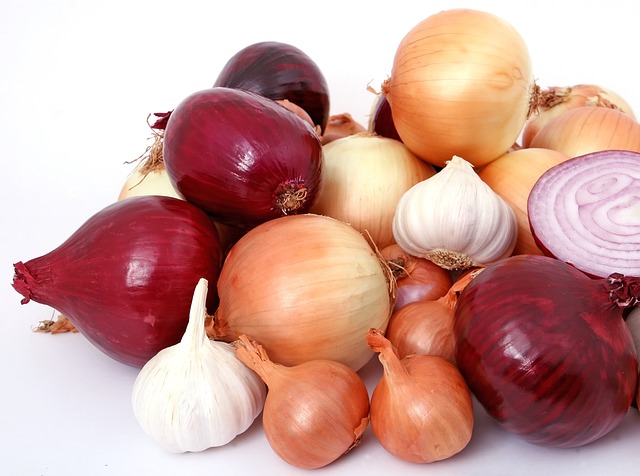History and Harvest
Did you know there are over 20 varieties of onions? It’s true! From green onions (a.k.a. scallions) to red, white, and yellow onions and even shallots, you have no reason not to add these layered beauties to more of your meals. Let’s review this affordable, accessible vegetable. According to the National Onion Association, some food researchers believe onions originated in central Asia, while others think they may have come from West Pakistan and Iran. Today, onions are grown in many parts of the country including California, Washington, Idaho, and Eastern and West-Central Oregon. Onions are also grown in China, India, and Egypt. Don’t forget wild onions, too. These may be sprouting in your yard!
Nutritional Prowess
Did you know you could eat an entire medium onion for under 45 calories? It’s unlikely you’ll do that, but onions are a great addition to any recipe (except maybe chocolate cake). Once they’ve been made into onion rings, however, all bets are off on the calorie load. Onions add taste, texture, and fiber to soup, stew, salad, and more. They’re an excellent aromatic vegetable that adds flavor without butter or salt. Onions are a source of B vitamins, vitamin C, and quercetin, a flavonoid compound with antioxidant and anti-inflammatory properties. Quercetin is also found in apples. Onions also provide fiber known as FOS (fructooligosaccharides), which is fermented and acts as a prebiotic to feed the healthy bacteria in your large bowel. Keep your gut happy — gas is good!
Health Bonuses
It’s worth adding onions to your salads, sandwiches, sauces, and other dishes. Quercetin has been found to have anti-cancer properties including reducing oxidative stress, enhancing sensitivity to chemotherapy drugs, and cell growth reduction. It has been used in the treatment of pancreatic, ovarian, and prostate cancer, and may also impact lung cancer. Fruits and vegetables may aid in reducing the risk for cardiovascular disease, since they help lower blood pressure and arterial inflammation. Glucoside compounds found in onions appear to have the highest bioavailability in humans. These compounds are metabolized in the liver and travel in various forms in the blood. A supplemental form of quercetin called aglycone has been found to reduce blood pressure. More research is needed to evaluate the amount of quercetin from plant sources needed to lower blood pressure in humans. A recent review article also indicates that quercetin from onions is lipophilic and crosses the blood-brain barrier easily. This suggests it may have neuroprotective effects due to its antioxidant, anti-inflammatory, and anti-diabetic properties.
Just Add Onions
There are so many delicious varieties of onions to eat! Where will you start?
- Add chopped white, yellow, red, or green onions to your omelets or frittatas.
- Pickle red onions and add them to tacos or sandwiches.
- Sauté onions with mushrooms and ‘smother’ a chicken breast or piece of fish with them.
- Toss a few red onion rings or chopped scallions in your salad.
- Season black or pinto beans with diced onions, cumin, and chili powder.
- Include onions in pasta, rice, or other grain dishes.
- Make a quesadilla with grilled onions and peppers.
- Try sautéed onions and zucchini together for a side dish.
By Lisa Andrews, MEd, RD, LD
Copyright foodandhealth.com, reprinted with permission.

